The Rise of Electric Integrated Ovens and Hobs: A Comprehensive Guide
In the world of contemporary cooking areas, electric integrated ovens and hobs have actually ended up being necessary appliances, offering performance, design, and convenience. As culinary practices develop, so too do the technologies that make cooking simpler and more pleasurable. This post explores the features, advantages, installation factors to consider, and upkeep tips for electric integrated ovens and hobs, while resolving typical often asked concerns.
What is an Electric Integrated Oven and Hob?
An electric integrated oven and hob is a combination cooking home appliance that effortlessly fits into kitchen cabinets. Developed to enhance area and aesthetic appeal, these appliances use the double functionality of an oven and a hob (cooktop) without jeopardizing on performance.
Key Features of Electric Integrated Ovens and Hobs
- Space-Saving Design: These appliances are built to fit nicely into kitchen units, maximizing available area.
- Touch Control Panels: Many models include touch-sensitive controls for simple operation and streamlined look.
- Advanced Cooking Functions: Options like convection baking, barbecuing, and steaming deal with various cooking styles.
- Energy Efficiency: Electric integrated ovens generally offer much better thermal performance compared to traditional gas models.
- Safety Features: Child locks, automated shut-off, and heat signs enhance safety throughout cooking.
Benefits of Electric Integrated Ovens and Hobs
The adoption of electric integrated ovens and hobs in households includes many benefits that attract a vast array of cooking lovers, from novice cooks to professional chefs. Here are a few of the most considerable advantages:
1. Efficiency and Consistency
- Uniform Cooking: Electric ovens and hobs supply constant heat circulation, leading to equally cooked food.
- Reduced Cooking Times: Advanced innovations, such as induction heating, can substantially minimize cooking times.
2. Easy to Clean
- Smooth Surfaces: The smooth surface areas of integrated designs eliminate food traps, making them simple to wipe down.
- Self-Cleaning Options: Many modern-day ovens included self-cleaning functions that simplify upkeep.
3. Aesthetic appeals
- Modern Look: An integrated style provides a unified look in the kitchen, making the area appear more contemporary and curated.
4. Versatility
- Multi-Functionality: Cooking alternatives range from baking and barbecuing to frying and simmering, dealing with varied culinary requirements.
- Time-Saving: Can prepare numerous dishes simultaneously, optimizing meal preparation.
5. Cost-Effectiveness
- Lower Energy Bills: Electric appliances are normally more efficient, resulting in prospective savings on energy costs gradually.
Setup Considerations
Integrating electric ovens and hobs into your kitchen needs correct preparation and factor to consider. Here are some important factors to remember:
- Space Measurement: Ensure that the dimensions of the home appliance line up with the designated installation area.
- Electrical Requirements: Check for sufficient electrical supply, consisting of voltage and amperage to support the device.
- Ventilation Needs: While electric appliances do not require gas ventilation, appropriate space for air flow is still required.
- Cabinet Compatibility: Ensure cabinets can support the combined weight of the oven and hob.
- Professional Installation: Engaging with a qualified technician is recommended for safe and compliant installation.
Upkeep Tips for Electric Integrated Ovens and Hobs
Keeping an electric integrated oven and hob guarantees durability and optimal efficiency. Here are some maintenance practices:
- Regular Cleaning: Wipe down surfaces frequently and make sure spillages are cleaned up as soon as possible.
- Inspect Seals: Ensure that door seals are intact to avoid heat loss, which can impact cooking efficiency.
- Self-Cleaning Cycle: Utilize the self-cleaning function if available, at least once every couple of months.
- Inspect Wiring and Cords: Check for harmed cables or connections to avoid electrical hazards.
- Set Up Professional Servicing: Regularly set up service can identify concerns before they end up being considerable problems.
Often Asked Questions (FAQs)
1. Are electric ovens better than gas ovens?
Electric ovens provide more constant heat and typically have features like convection cooking, which can boost the cooking experience. Lots of users find them easier to clean and much safer than gas ovens.
2. What is the distinction between induction and ceramic hobs?
Induction hobs use magnetic fields to heat pots and pans directly, while ceramic hobs utilize electric coils beneath a glass surface to warm the cooking surface area. Induction hobs are typically more energy-efficient and quicker than ceramic options.
3. Can I set up an electric oven and hob myself?
While it is possible for experienced DIY enthusiasts to install their appliances, expert setup is recommended to ensure compliance with safety requirements and local policies.
4. How do Best built in oven and gas hob packages understand if my oven is carrying out efficiently?
Screen cooking times and temperature settings. If food is consistently undercooked or overcooked, it may show that the oven needs recalibration or maintenance.
5. How can I enhance the life-span of my electric oven and hob?
Routine cleansing, appropriate use, and regular professional maintenance can considerably extend the lifespan of these appliances. Preventing fast temperature level modifications can likewise assist in maintaining their stability.
Electric integrated ovens and hobs represent the advancement of cooking appliances, marrying functionality with contemporary design. Their effectiveness, ease of use, and aesthetic appeal make them an excellent choice for contemporary cooking areas. As cooking technology continues to advance, both home cooks and culinary professionals can expect even higher innovations in the realm of electric integrated cooking solutions.
With the best upkeep and installation practices, these appliances can enhance both the cooking experience and the overall performance of the kitchen space.

